How To Choose the Right Espresso Machine (4 Key Tips)
Do you need all those buttons to make good espresso?
I sure thought so. A few years back, I got swept away by the sleek design, flashing lights, and promises of “café-quality coffee at home.”
I won’t even mention the brand, let’s just say it rhymed with “Regret-presso.” It looked amazing on my counter, but the shots? Weak, bitter, and honestly, a little soul-crushing.
I didn’t know what I didn’t know. I had no clue what a boiler system was, or why pressure mattered, or that the grinder was as important as the machine. I assumed if it was expensive, it must be good. Well, it wasn’t!
So, if you’re feeling overwhelmed by all the espresso machine options out there, such as manual, semi-auto, super-whatever, you’re not alone.
In the next few minutes, I’ll walk you through the 4 key things you need to look at before choosing an espresso machine. So let’s start brewing!
Key Takeaways
Choose the Right Machine Type for Your Lifestyle: Manuals give full control (and a challenge), semi-autos balance effort and flexibility, while super-automatics offer one-touch convenience. Don’t overbuy—match the machine to your daily coffee habits.
Boiler Type Affects Speed and Milk Frothing: Single boilers are budget-friendly but slower. Heat exchangers and dual boilers let you brew and steam at the same time. This makes them ideal for latte lovers and multitaskers.
Build Quality and Pressure Matter for Flavor: Aim for machines with solid components (like brass or stainless steel) and stable 9-bar pressure. I recommend skipping the cheap plastic models unless you enjoy bitter shots and breakdowns.
Think Long-Term: Maintenance and Costs Add Up: Budget for a good grinder, cleaning supplies, and maybe a water softener. A well-maintained machine not only lasts longer but also keeps your espresso tasting consistently great.
4 Keys To Pick the Right Espresso Machine
Picking the perfect espresso machine isn’t about looks or price. Instead, it’s about how well it fits into your daily routine and goals as a home barista.
1 – Type of Espresso Machine (Pick What Fits Your Lifestyle)
In the beginning, I had no clue that espresso machines even had “types.” However, picking the right one matters a lot.
The reason is choosing the right type impacts everything from your daily coffee brewing and enjoyment (and sanity). So here’s what to look for:
Manual Espresso Machines
For instance, the iconic La Pavoni Europiccola is one of those classic lever-style machines that baristas geek out over.
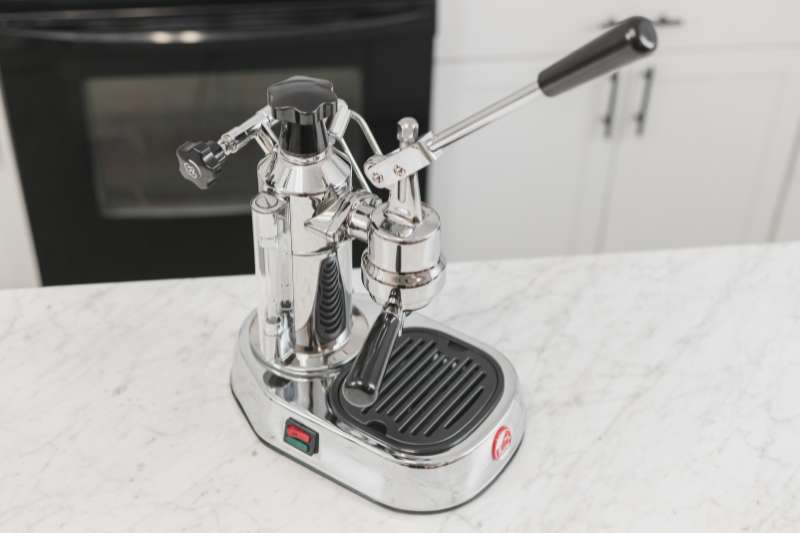
These machines give you full manual control over everything, such as pressure, timing, and extraction. But as you can imagine, they’re not for everyone! It takes time and practice to perfect your espresso shots. In other words, it’s not just pushing a button and having your coffee ready.
| Pros | Cons |
|---|---|
| Complete Extraction Control: You can tweak literally every shot variable, which means once mastered, you can achieve truly phenomenal espresso. | Learning Curve: Expect a fair amount of disappointing shots before you nail that first one. |
| Timeless Aesthetic: Seriously, these machines look incredible. People notice them immediately when they walk into your kitchen. | Time-Consuming: You can’t just quickly pull a shot and run out the door. It’s a ritual, so it takes time. |
| Durability: Manual machines, if maintained properly, can last decades. You might even pass one down to your kids. | Zero Automation: There’s no built-in timer, grinder, or preinfusion settings. Everything is manual, so you need separate gear and good timing. |
Semi-Automatic Espresso Machines
One of my first machines was the Rancilio Silvia, a beloved choice among home baristas worldwide.
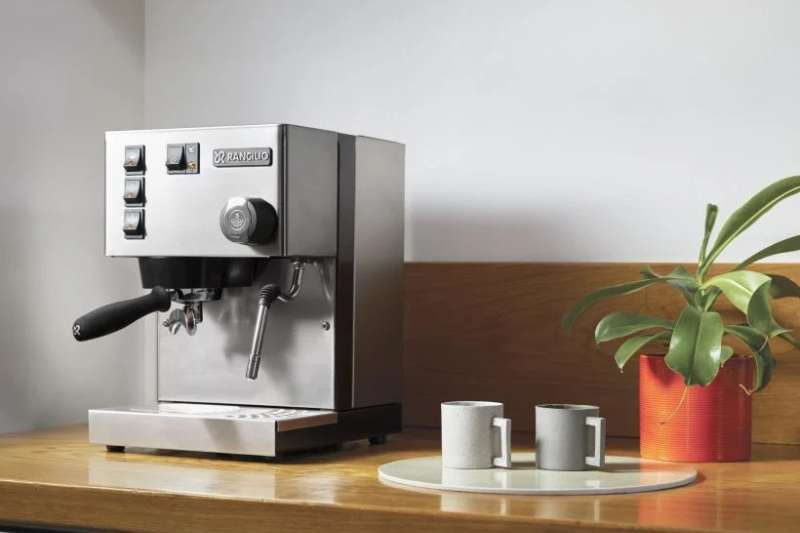
With semi-automatics, you handle the grind, dose, tamping, and timing. However, the machine automatically delivers water at consistent pressure. This is the sweet spot between manual control and convenience.
| Pros | Cons |
|---|---|
| Balance of Control and Convenience: You control enough to fine-tune your espresso, but the pressure is consistent. So you have fewer variables to go wrong. | Consistency Requires Practice: You’ll probably pull some sour or bitter shots at first, learning grind and dose. |
| Reliable and Durable: Many semi-autos like the Silvia are built to last decades, making them worthwhile investments. | Separate Grinder Required: You’ll need a separate espresso grinder, which adds cost and counter space. |
| Great Learning Tool: Perfect for developing your espresso-making skills and growing into a true home barista. | Slightly More Time-Consuming: More manual steps than automatic options mean it’s not quite grab-and-go. |
Full Automatic Espresso Machines
A popular example of full automatic machines is the Breville Barista Express. These machines handle grinding, dosing, and controlling shot extraction automatically.
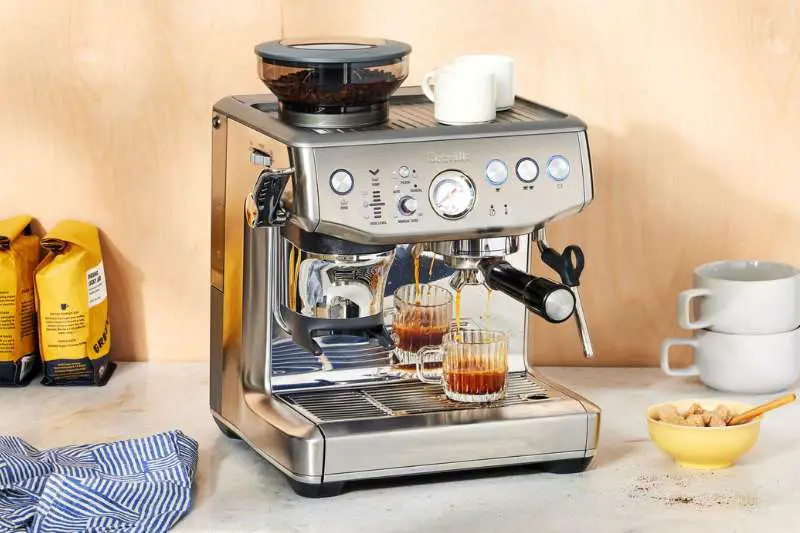
Basically, you only handle the tamping. It simplifies the espresso routine while still feeling like you’re involved in the brewing process.
| Pros | Cons |
|---|---|
| Convenience of Built-In Grinder: Saves money and counter space by combining espresso machine and grinder. | Limited Customization: There’s less control over precise grind adjustments or pressure profiling compared to higher-end setups. |
| Consistency: Good at pulling reliably decent shots, even if you’re not super experienced. | Built-In Grinder Quality: Typically, these integrated grinders aren’t as adjustable or high-quality as standalone grinders. |
| Faster Workflow: Compared to semi-auto or manual machines, these streamline your morning coffee. | Maintenance & Reliability: Built-in grinders and automation mean more internal moving parts. So this increases maintenance needs over time. |
Super-Automatic Espresso Machines
A good example here is the Jura E8, which is basically an espresso robot. I mean, you push a button, and they grind, dose, tamp, brew, and even froth your milk automatically. For this reason, they’re perfect if you like convenience.

| Pros | Cons |
|---|---|
| Maximum Convenience: Zero espresso-making knowledge is required. You get a perfect espresso at the push of a button. | Expensive Upfront Cost: These machines are pricier due to automation and technology involved. |
| Fast & Easy to Use: Great for busy mornings or households where multiple people use the machine daily. | Limited Espresso Customization: Little control over shot variables like pressure or extraction time, resulting in fewer options to fine-tune your coffee. |
| Minimal Mess and Fuss: Super easy to maintain and clean. Usually, you only need to rinse components and perform periodic descaling. | Costly Repairs: If things break down, repairs can be complicated and expensive due to intricate internal mechanisms. |
Who Each One is Best For:
- Manual: Espresso hobbyists and enthusiasts who truly enjoy mastering the art and science of espresso brewing.
- Semi-Automatic: Coffee lovers who want great espresso with the ability to learn and improve their skills over time.
- Full Automatic: Ideal for casual espresso drinkers who appreciate good coffee without a complicated process.
- Super-Automatic: Best suited for busy households, offices, or anyone who values convenience and speed above customization.
Pod-Based Machines (e.g., Nespresso) vs Traditional Espresso
Pod machines like Nespresso Vertuo are easy and fast to use. For instance, you pop in a capsule and press a button. The espresso produced is decent enough, and it’s great for a hassle-free caffeine fix.
However, pod-based espresso generally lacks the depth of flavor, crema texture, and richness you get from traditional espresso machines.

Plus, pods get expensive fast and produce a fair bit of waste even with recycling programs available.
If you’re truly into espresso and care about flavor, customization, and the environment, traditional espresso setups ultimately win out.
2 – Single Boiler vs Dual Boiler vs Heat Exchanger
First off, single boiler machines have one boiler that handles both espresso brewing and steaming milk, but never at the same time.
For example, the Gaggia Classic Pro falls into this category. It means you gotta wait between pulling your shot and steaming milk. Usually, this option is fine if you only want espressos. But for latte lovers, it gets old quick.
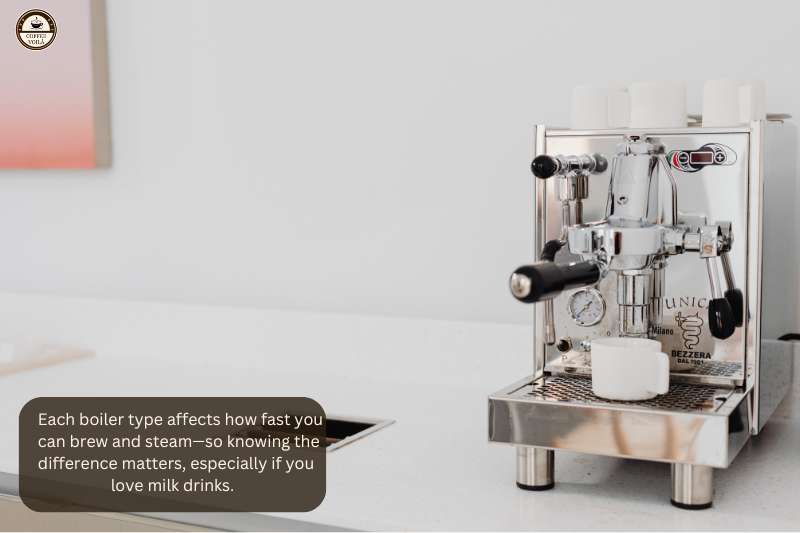
Now, Dual boiler espresso machines, like the Breville Dual Boiler, have separate boilers: One specifically for espresso and another for steaming milk. This means you can do both at the same time. As you can imagine, this is great if you’re into cappuccinos or flat whites.
Lastly, you have heat exchanger (HX) machines. This uses one boiler but heat brewing water indirectly through a heat exchanger tube.
A popular example here is the Rocket Appartamento. They allow simultaneous brewing and steaming. However, temperature stability may be less precise than that of dual boilers.
How Does This Impact Your Brewing and Steaming?
Well, as I said if you enjoy milk drinks like lattes or cappuccinos, dual boiler or heat exchanges are better. With single boilers, by the time your milk is done steaming, your espresso’s already cooled off.
Tips for people who love milk drinks like lattes
If you make milk-based drinks regularly, I’d highly suggest budgeting a bit more for at least an HX, preferably a dual boiler setup.
Also, keep an eye on the steam wand quality. For instance, dry steam is way better for silky microfoam than wetter steam (which can be an issue on cheaper machines).
Importance of temperature stability for flavor consistency
The fact is espresso extraction needs a precise temperature range (usually between 90°C and 96°C).
If your boiler fluctuates too much, you’ll either get sour (under-extracted) or bitter (over-extracted) shots.
That’s why dual boiler and high-quality HX systems are so valuable. They maintain steady, consistent temperatures during extraction. For this reason, you more easily brew delicious espresso every single day.
Notes: I suggest investing wisely in the boiler system because it impacts your coffee quality and everyday experience.
3 – Pressure, Build Quality, and Components
When I first jumped into espresso making, I grabbed a super-cheap machine (let’s just say it rhymes with “Mr. Roffee”). It had plastic everywhere and was louder than my blender.
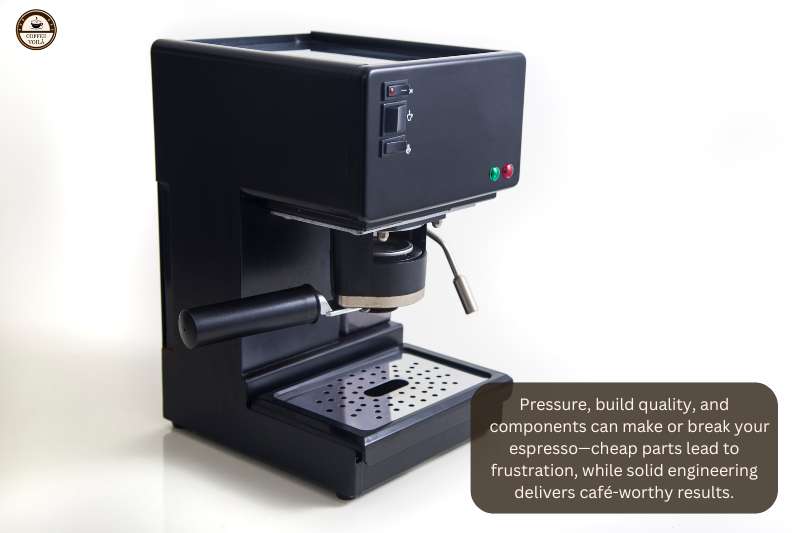
After just a few months, shots got watery, and the pump started struggling. Eventually, I upgraded to something solid, like a Rancilio Silvia. Night and day difference. Build quality matters big-time, not just for durability but also for how your espresso tastes.
What Makes an Espresso Machine Durable & Effective
First things first: you need at least 9 bars of pressure for great espresso. Some cheaper machines brag about higher pressure, like 15 or 19 bars. However, that’s mostly marketing fluff.
A consistent 9-bar extraction gives you that sweet, balanced espresso with rich crema you’re after. Any more or less pressure and your shots tend to come out bitter or sour.
Espresso Machine Materials
Always look for espresso machines built from sturdy stuff like brass or stainless steel.
Typically, machines with lots of plastic parts feel flimsy and break down quickly. On the other hand, brass and stainless steel hold up better against heat and corrosion. So your machine lasts way longer and feels premium.
Group Head and Portafilter
A heavy, well-made portafilter (preferably brass or stainless steel) retains heat better, ensuring stable extraction temperatures. Initially, I had a cheap plastic portafilter that constantly made my espresso shots run cold and taste bland.
With a solid machine like the Silvia, you can actually feel the difference. The group head’s got real heft to it, and that extra mass helps keep the temperature stable. As a result, you get higher-quality shots.
Rotary vs Vibratory
Vibratory pumps are common in home machines (including my old cheapie) but are loud and create lots of vibration.
Now, rotary pumps, common in higher-end models like the Lelit Bianca or ECM Synchronika, are quieter, last longer, and provide smoother, more consistent water flow.
Of course, they cost more. But the difference in shot consistency and quietness is worth it—especially if you’re pulling shots early in the morning and don’t want to wake the whole neighborhood.
Notes: Skimping on build quality and components might save you some cash initially. However, you’ll pay for it later with frustration, inconsistent espresso, and a shorter lifespan.
That’s why investing upfront in a machine with proper pressure, solid build, and quality components makes life a whole lot easier. And more importantly, your espresso tastes way better.
4 – Budget & Long-Term Maintenance
When I first got serious about espresso, I massively underestimated how much the long-term upkeep would cost. All I could see was the shiny espresso machine and not the accessories, ongoing cleaning, and possible repairs down the line. I learned fast that the machine itself is just part of the story.
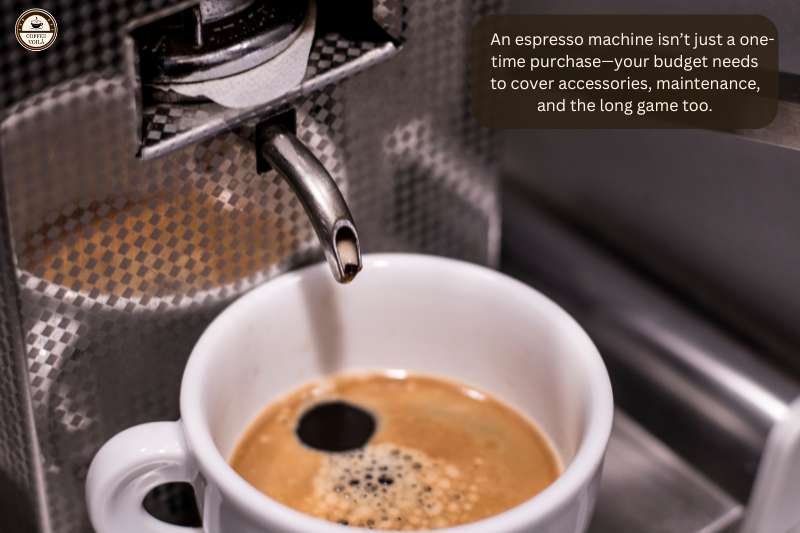
Think Beyond the Price Tag
To get a better sense of real-world costs, here’s a simple breakdown of espresso machines at different price points with examples to help you out:
| Price Tier | Example Espresso Machine | Avg. Cost | Quick Notes |
|---|---|---|---|
| Entry-Level | De’Longhi EC155 | ~$120 | Basic features, entry-level build, vibratory pump |
| Mid-Range | Gaggia Classic Pro | ~$450 | Reliable build, commercial-style portafilter |
| Prosumer | Lelit Bianca V3 | ~$3,000 | Dual boilers, rotary pump, flow profiling capability |
The key takeaway? Don’t just get drawn to the lowest price or the flashiest features—think honestly about how you’ll use your machine daily and what it’ll cost to maintain it long-term.
Cost of Accessories (Grinder, Scale, Tamper)
A good grinder alone could set you back another $150–$400. A decent scale for measuring coffee doses accurately commonly goes around $30–$50, and it’s worth it.
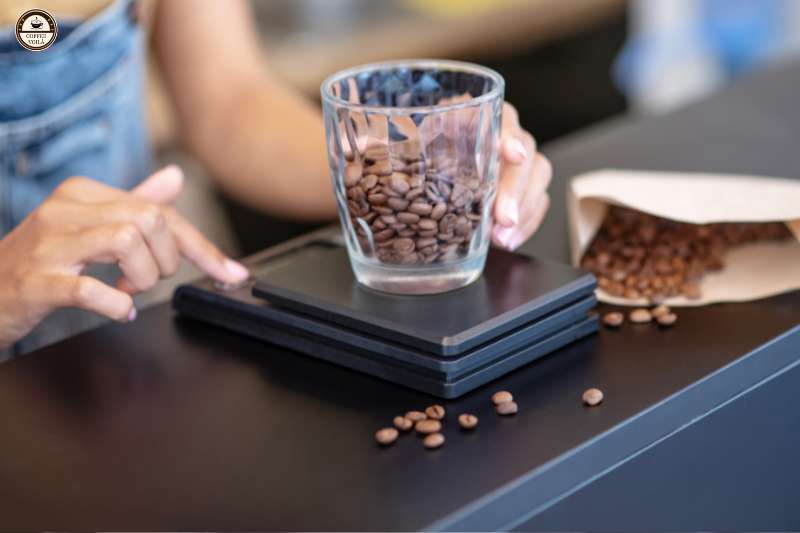
Often tampers are overlooked. However, the cheap plastic one my first machine came with was pretty useless, and later, I upgraded to a Lelit Tamper.
A good stainless-steel tamper costs about $30–$50. But genuinely makes your espresso more consistent.
Notes: At least budget an extra couple hundred dollars for these accessories; they’re not optional if you’re serious about espresso.
Water Filtration, Descaling, and Weekly Cleaning Tips
A good friend once told me, “your espresso will only ever be as good as the water you put in it.” I ignored him at first, thinking regular tap water was fine.
But my machine quickly got clogged with mineral buildup. I learned my lesson, so now I always use filtered water. Or even better you could have a dedicated water-softening system like the BWT Bestsave or BWT Penguin pitcher, especially if your area’s water is hard.
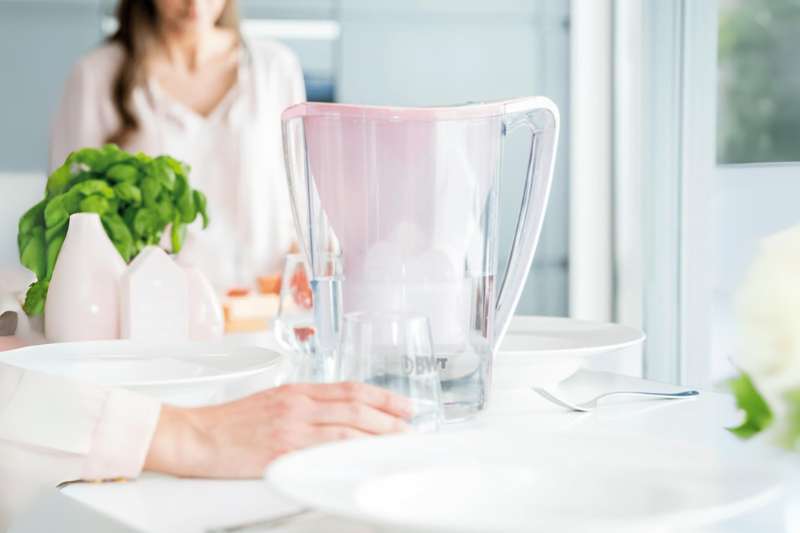
I also suggest descaling about once every month or two (depending on use and water hardness). This keeps your machine running smoothly.
Meanwhile, weekly cleaning routines should include backflushing (for semi-autos and prosumer machines), scrubbing your group head, and soaking the portafilter and baskets overnight occasionally.
I know it sounds boring (well, it is!) But your espresso stays delicious and your machine will last years longer.
Serviceability: Can You Find Parts or Help When Needed?
Another thing I didn’t think about until way later was serviceability. Sure, that rare Italian-made machine on eBay looks amazing.
However, can you find replacement parts if something breaks? Or a local technician who knows how to fix it? So, go with a brand or model that has a strong community or official distributor support.
For instance, brands like Gaggia, Breville, Rancilio, and Lelit usually have readily available parts and clear troubleshooting info online.
Note: Having a reliable, easy-to-service machine is priceless when something inevitably goes wrong. And believe me, even the best machines run into problems every once in a while.
Final Tips Before You Buy
Here’s some friendly, practical advice I wish someone told me sooner.
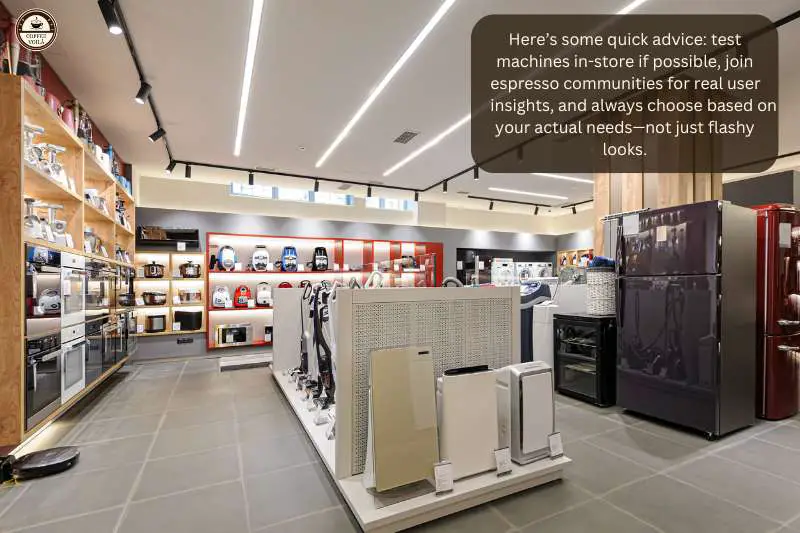
1 – Try Before You Buy
When you head over to local kitchen appliance stores, coffee specialty shops, or even coffee expos, ask if you can try the espresso machines.
Some shops even let you pull a test shot. Actually seeing how it feels to use different machines gives you way better insight than just reading specs online. Another option is to ask a friend if you can borrow their machine for a weekend.
2 – Join Espresso Communities
Joining coffee communities was one of the smartest moves I ever made.
For instance, places like the espresso subreddit (r/espresso), specialized coffee forums (Home-Barista.com is gold), or Facebook groups like Home Espresso Aficionados are loaded with helpful advice and first-hand user experiences.
Of course, I’ve gotta talk about my own site too, Coffee Voilà (hey, at least I’m honest about it). Here you’ll find real, detailed reviews that break down what’s good, what’s bad, and what’s hype.
These groups and communities are great for troubleshooting, gear recommendations, and just generally keeping your espresso enthusiasm alive.
3 – Start With Your Needs, Not What Looks Flashy
My first big espresso mistake was going for the prettiest, shiniest machine I could afford.
Meanwhile, I ignored what I actually needed. Yeah, a polished stainless steel machine with walnut handles looks amazing. But maybe what you need is a simpler machine that’s quick, easy, and suits your daily routine.
If you rarely drink milk-based drinks, you probably don’t need a dual-boiler beast. Or if your mornings are chaotic, a manual machine is gonna drive you nuts.
Always consider your daily coffee habits, patience, kitchen space, and maintenance tolerance before aesthetics.
Last Thoughts
Alright, that covers the essentials for choosing an espresso machine that’s right for you. But hey, maybe you’ve still got some burning questions about boilers, grinders, or what machine fits your lifestyle best.
Or maybe you’ve got a golden tip that helped you pick out your dream espresso setup.
Either way, I’d genuinely love to hear from you. So, drop your questions or share your advice in the comments. And with that, we wrap it up with a cheerful ‘voilà!’”
Questions? We Have Answers.
Get answers to a list of the most Frequently Asked Questions.







